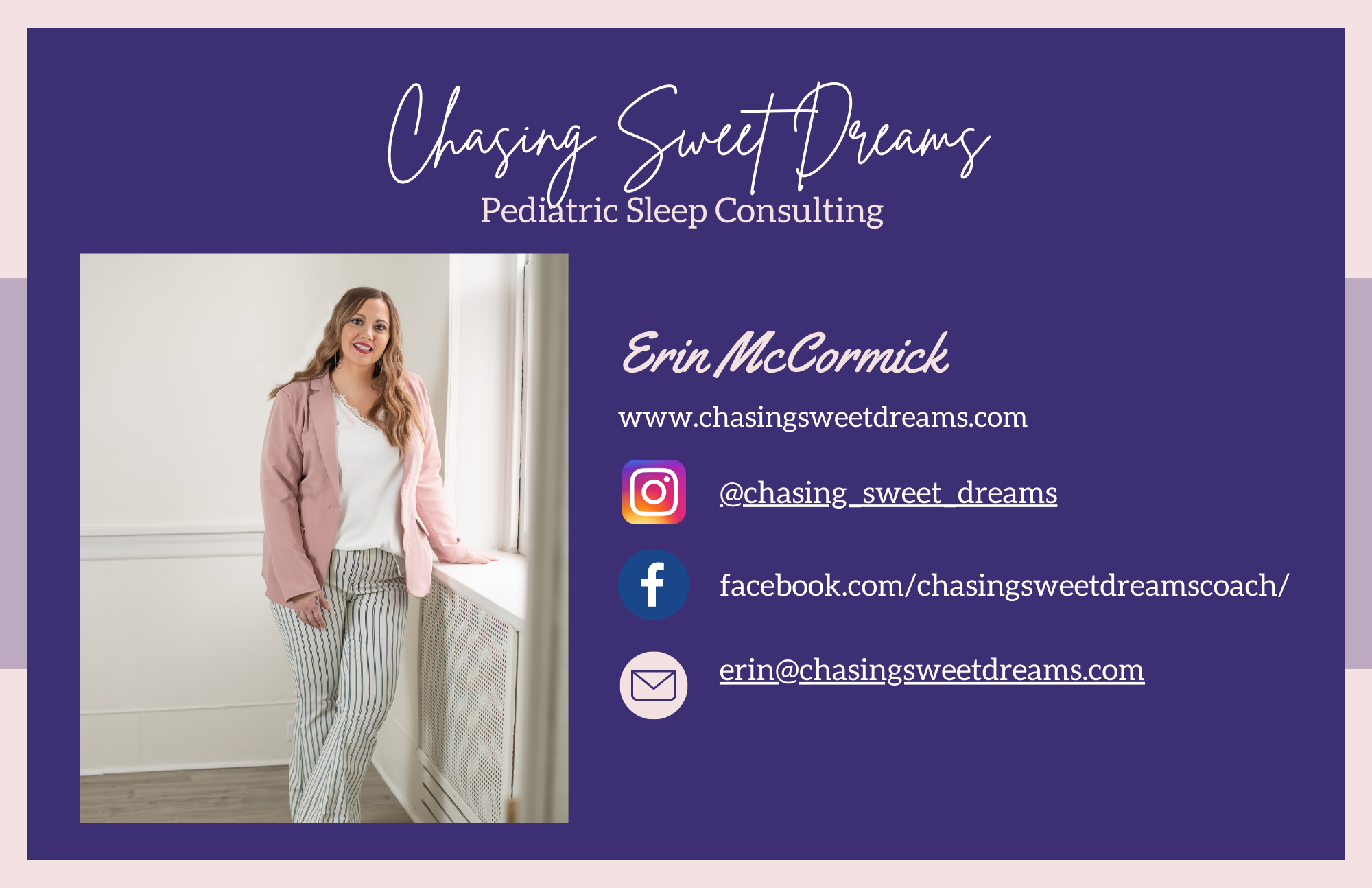Important Sleep Basics All Parents, and Caregivers Should Know
At Chasing Sweet Dreams, we like to solve as many problems as we can with as little parental sleep deprivation and hassle as possible.
Understanding and implementing the information we will discuss —which may seem simple and intuitive at times—can lead to major sleep improvements with very little stress for all involved.
Safety First
The families we work with make different choices when it comes to where and how they prefer their baby to sleep, and we support that. We encourage you to make your decision from an informed perspective, weighing the risks and benefits of your options. We always recommend discussing your sleep arrangement choices with your pediatrician and following the current safety recommendations of the American Academy of Pediatrics.

Click here to listen to the podcast
Understanding What Drives Your Child to Sleep
Knowing when your baby is ready for sleep is very important. Sleep pressure and the circadian rhythm are the main drivers of your child’s sleep. These two sleep drives should be working together as you implement your sleep teaching strategies to maximize your success.
Sleep Pressure
Sleep pressure is simply the accumulation over time of the need for sleep. In other words, it’s how tired your child is. The longer your child is awake, the sleepier she becomes (which doesn’t necessarily mean it’s easier for her to fall asleep). Your baby will typically experience the highest sleep pressure at bedtime.
When your child has a nap or some night sleep, the sleep pressure wears off a bit, and she can stay awake for another stretch of time. The length of time your child sleeps matters: Often, the longer your child has been asleep, the longer she can then stay awake. This is why wake-ups in the middle of the night and early morning can be more challenging problems to solve than those at bedtime. Sleep pressure also determines your baby or toddler’s nap needs, and is what leads to over-tiredness or sleep deficits.
The Circadian Rhythm
The circadian rhythm is your internal biological clock or sleep system; it controls the timing of many events in your body. Sleep is one of those events, in addition to things such as hormone production, bathroom needs, and meal timing. The circadian rhythm is complex! Because it is controlled by exposure to light and dark, your child’s room environment is important during times of sleep. The circadian rhythm begins to consolidate your newborn’s sleep at night and wakefulness during the day, starting around 6-7 weeks old (usually coinciding with the onset of social smiling). Regular bedtimes pop up around 3 months. By 6 months, it becomes the main force behind your child’s sleep patterns. The circadian rhythm also does some counterintuitive things, such as strongly promoting wakefulness during the Wake Maintenance Zone (the “second wind”) right before it promotes sleep at bedtime. It is important to understand this phenomenon—and what affects it—when choosing the most successful time to begin your sleep teaching.
.The circadian rhythm works best with consistency. Wide ranges in bedtimes and wake times can disrupt the rhythm, which is not helpful to your child during a period of change. For this reason, you’ll want to put your baby to bed within the same 30-minute window each night and start her day within the same 30-minute window each morning as often as you can.
 See our Sleep Quantity and Timing Chart to help determine age-appropriate expectations for your baby.
See our Sleep Quantity and Timing Chart to help determine age-appropriate expectations for your baby.
Sleep During the Night
Babies with mature sleep patterns have deep sleep dominating the first third of their night. After this, lighter stages of sleep (such as stage 2 and REM) take over. Once your child enters deep sleep, this will likely be her longest, best stretch of sleep in the night. You could watch a loud movie, or a sibling sharing the baby’s room could call for you and still not wake a baby in deep sleep. Later in the night, however—especially the last third of the night—things change. This is the time of night when your child is most likely to be awakened by the noise and it’s also harder for her or her to go back to sleep. Sleep problems during this time of night are some of the most challenging.
Sleep cycles occur every 60–90 minutes at night, with a brief wake-up at the end of each cycle. This is normal, natural, and has no cause for concern. The trouble arises if your baby doesn’t know how to go back to sleep on her own at these wake-ups. In that case, she may end up calling for you every 60–90 minutes, and for most families that isn’t sustainable long-term.
REM sleep is when your baby dreams. It typically dominates the early morning sleep. Young babies make a lot of noise while in REM sleep (laughing, crying, and sucking) because they do not have REM-sleep paralysis the way adults do. Because of this, they may also “practice” motor skills such as rolling, rocking on all fours, and even sitting, which sometimes causes them to wake up. This is the time of night when your baby is most susceptible to being awakened by noise, so an ideal sleep environment throughout the night is essential.
Sleep During the Day
Daytime sleep for babies consists mostly of REM sleep: the movement-filled sleep that can sometimes be disruptive (see above). Sleep pressure tends to be lower during the day, which makes it harder for your child to fall asleep. In addition, daytime sleep cycles are only about 30–45 minutes, at which point your baby will wake briefly. Many babies have trouble going back to sleep after this wake-up, and parents find themselves stuck in a pattern of single-sleep-cycle naps. Day sleep is typically the last to get organized, and some babies won’t have a predictable daytime sleep schedule until 5.5–6 months after the due date.
The Sleep Environment
The sleep environment during both night and day is important. Some parents believe it is best to get their baby used to sleeping in noisy, unpredictable locations in order to make them more adaptable, but research has shown that people of all ages sleep best under conditions of cool, dark, and quiet.
Cool: Because over-bundling and overheating have been associated with SIDS, and because body temperature needs to drop at times during the night, we consider cooler temperatures safer and more conducive to sleep. We encourage you to dress your baby appropriately for the temperature. Room temperatures of 68-72° Fahrenheit are ideal. Be sure that your baby’s feet are covered with socks, a sleeper, or a wearable blanket. Evaluate your baby’s core temperature by putting a couple of your fingers down her chest or back. Your baby should feel warm and dry at the core. If she is clammy, sweaty, or hot, she may be overheating. Don’t worry if your young baby’s nose, fingers, or ears feel a little cool to the touch, as this is typically due to tiny blood vessels and developing circulation; it does not mean your baby is too cold.
Dark: Darkness at night is non-negotiable. You want your baby’s little body to be in the dark from her desired bedtime until her desired wake-up time. Also, turn off all screens, phones, and tablets at least 30–60 minutes before your child’s bedtime and keep them off throughout the night.
During the day, darkness is important because it helps to neutralize surroundings and make them less interesting. A napping room should be too dark to read. Our favorite tips for darkening a room include hotel-grade blackout material from any local fabric store and a box of thumbtacks; EZ Blackout blackout shade available here; blackout cellular shades/lined drape combo; or even a dark beach towel or quilt draped over a window. For light cracks, some double-sided tape or velcro can adhere a curtain to a wall quickly and easily.
Quiet: Humans sleep best in the quiet! It’s possible your baby can learn to go back to sleep after being awakened by a noise, but we prefer to prevent that from happening in the first place. For this reason, quiet sleeping rooms are best. If you live in a place where it’s not quite (e.g., sirens and traffic, noisy neighbors, barking dogs, creaky house or snoring parents, etc.), we recommend a continuous white noise machine. A white noise machine will not teach your baby to sleep, but it can protect her sleep by masking those bumps in the night. White noise machines should stay on all night (not set to a timer) and be set to unchanging sounds such as rainfall or waterfall, rather than waves crashing or whales breaching. Adjust the volume so the noise level feels comfortable, not stressful or intrusive. Place the noise machine between your child and where the sound is coming from, not right under your child’s head.
 Is Sleep
Is Sleep Training aka Sleep Teaching?
I prefer to call it to sleep teaching. We train a dog not a child.
Some parents choose a sleep-teaching strategy that helps them reach their goals very quickly, and other parents prefer gradual changes. Some parents are comfortable leaving their child’s room, and others prefer to be with their child at all times. Because current research doesn’t tell us which way is “best,” we are neutral when it comes to a particular sleep intervention or parenting style. We know that there is more than one “right” way to accomplish your family’s goals for improved sleep, and we don’t force or even recommend a one-size-fits-all approach. What works for your first baby may not be right for your second, and what was best during one developmental stage may not be best during another. Our loyalties lie with our little customers, so we strive for changes that fall within the realm of infant sleep science and age-appropriate expectations, keeping in mind what each family feels is the best fit for their baby’s temperament, the realities of their family life, and their parenting style. If you need help implementing these changes for your baby, schedule a free 15 min. discovery call with me today.
In 2020, I have helped hundreds of families regain their sleep and their sanity through my guilt-free, responsive sleep approach.
If your baby or baby is struggling with sleep, send me an email or set up a discovery call! I am here for you!
Sending sleepy vibes and sweet dreams your way!
Erin McCormick
Your Pediatric Sleep Consultant


